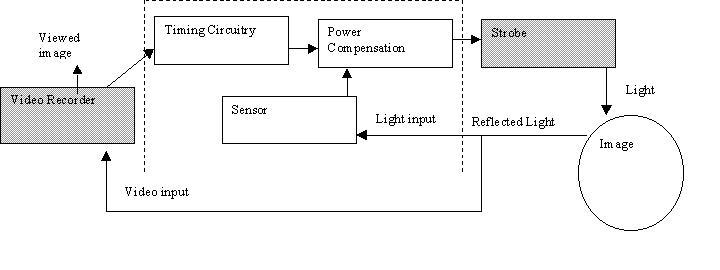Synchronized Strobe for Video
Camera
Jeff Baskett and Jason Zubo
Project Advisor: Dr. Irwin
Senior Project Functional Description
9/25/00
Functional Description
We are designing a circuit to control a strobe
that will be synchronized with the shutter on a video camera. Fig.
1 shows the general block diagrams with inputs and outputs to the respective
blocks. Based on the shutter speed of the camera, we plan to fire
a strobe during each frame to freeze high-speed motion preventing any blurring
effects. The only inputs into the system will be the video synchronized
signal from the camera and the intensity of the light read by the sensor.
The outputs will be the intensity of the light from the strobe. The recorded
image will be analyzed to determine the effectiveness of the system.
Figure 1 Block Diagram

Video Recorder
We will find the signal telling when the shutter
is open. This will be the output to the timing circuitry.
Timing Circuitry
The timing circuitry will use the shutter signal
from the camera to trigger the firing of the strobe by sending an appropriately
timed signal to the power compensation circuit. We will analyze the
synchronized signal from the video recorder to determine how the shutter
open time and the diameter of the iris are affected by the intensity of
the incoming light.
Sensor and Power Compensation
The sensor will read in the intensity of the reflected
light. The power compensation circuitry will read in the synchronized
signal from the timing circuitry. Based on the intensity level and
the synchronized signal, the power compensation circuitry will adjust the
power needed by the strobe to produce undistorted, appropriately lit images.
This will include compensating for shadows by powering other strobes and
strategically placing the strobes. The effects of incoming light
on the period of time that the shutter is open or the varying diameter
of the iris will be analyzed to adjust the power given to the strobe.
This will ensure proper operation in each frame.
Strobe
Our design will initially use a single strobe to
create a stop-motion effect for each frame of video. The need for
multiple strobes will be explored as the project advances. The use
of multiple strobes will needed if our power compensation circuit is not
capable of charging a single strobe to appropriate levels in the time between
frames.
|